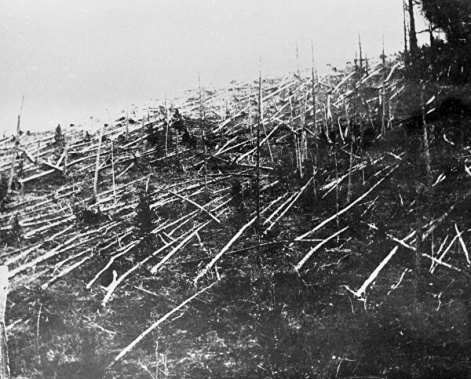The century-old secret of the Tunguska catastrophe is close to a solution
28 April 2020 г.

Wandering objects, asteroids and comets, attract the attention of scientists and ordinary people, as they pose a special threat to the inhabitants of the Earth. On June 30, 1908, an event occurred over Siberia in the region of Podkamennaya Tunguska, and scientists are still arguing about its reasons. Decades of investigations have not brought new results. The mystery of the Tunguska phenomenon remained unsolved, despite dozens of hypotheses.
Based on the calculations of the trajectory and mass of the space object, the external forces acting on it and changes in the initial velocity, scientists of the Federal Research Center KSC SB RAS, with the participation of young colleagues from several Russian academic institutes and universities, presented a new explanation of the Tunguska phenomenon. The researchers showed that the destruction created by the Tunguska cosmic body could have been caused by a shock wave. An explosive strike could have occurred when a cosmic body was passing through the Earth’s atmosphere, provided that it consisted of iron rather than ice, as cometary nuclei do. Note that examples of large cosmic bodies consisting of iron are well known. For example, 50 thousand years ago the Arizona meteorite with the initial size of more than 50 meters formed a crater 1200 meters in diameter and 200 meters in depth.
To test their theory and study in more detail the behavior of cosmic bodies when entering the atmosphere, the scientists created a model of the behavior of small asteroids in the Earth’s atmosphere.
“We calculated the trajectory characteristics for space objects with a diameter of 200 to 50 meters, consisting of iron, ice or rock, such as quartz and lunar soil. The model shows that the Tunguska body could not consist of stone nor of ice, since the low strength of these internally heterogeneous materials, unlike iron, leads to a rapid destruction of such bodies in the atmosphere under tremendous aerodynamic pressure, ” says the project supervisor Sergey Karpov, Doctor of Physical and Mathematical Sciences, leading researcher at the L.V. Kirensky Institute of Physics FRC KSC SB RAS, professor of the Institute of Engineering Physics and Radioelectronics SibFU.
In addition, the proposed model takes into account the change in the trajectory of the space body depending on aerodynamic drag, angle and velocity of entry into the atmosphere, properties of the constituent material and its passage through various layers of the atmosphere. Based on the simulation results, the researchers showed that the Tunguska phenomenon had been caused by an iron asteroid with the most probable size from 100 to 200 meters. This asteroid passed through the Earth’s atmosphere at a minimum flight altitude of 10–15 kilometers at a speed of about 20 kilometers per second. It continued its movement in the circumsolar orbit, losing about half of its initial mass, which could have exceeded three million tons, while maintaining its integrity.
Such an object could have created a shock wave, causing trees to fall in an area significantly exceeding one and a half thousand square kilometers without leaving any traces of the original body on the Earth's surface. In this case, the main contribution was made by a spherical component of this shock wave, which is characteristic of the explosion. The calculations show that its occurrence is associated with a sharp increase in the rate of evaporation of the body when approaching the epicenter in the upper layers of the troposphere, which can reach up to 500 thousand tons per second for a two-hundred-meter body due to the strong heating of its surface. It is this huge mass that can instantly expand in the form of a high-temperature plasma, creating the effect of an explosion. Thus, the colossal destruction on the Earth was not caused by the direct hit of an asteroid, but it was due to shock waves created by the passage of a large cosmic body through the atmosphere.
Another mystery of the Tunguska phenomenon is the cause of fires which swept the epicenter area of more than 160 square kilometers. The explanation of this phenomenon is associated with the action of high-intensity light radiation generated by the head of a bolide with the radiating surface temperature of more than 10,000 degrees at a minimum flight altitude. It is under such conditions on the Earth’s surface that the ignition temperature is reached for combustible materials, which are heated by absorbing optical radiation from the bolide in the estimated time of flight over the epicenter equal to 1-1.5 seconds.
“Simulating the behavior of various cosmic bodies in the Earth’s atmosphere will help to more accurately predict the degree of asteroid hazard. This is especially true for space objects larger than two kilometers. It is these asteroids that pose the greatest threat to our civilization. Model calculations will allow us to determine the probability of a collision of such objects with the Earth, their properties, consequences of their fall, as well as the characteristic features of their passage through the atmosphere even without colliding with the Earth’s surface, since the shock waves generated by this passage a have tremendous destructive force, ” explains Sergey Karpov.
Research in this direction is ongoing. Scientists have to get insight into a number of issues within the framework of the proposed model. These include, in particular, calculations of the amplitude of the shock wave in the epicenter under different conditions and the change in the temperature of the asteroid surface along the trajectory, as well as the time development the process of the body passage through the atmosphere, including its destruction.
Share:
